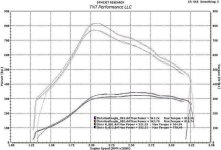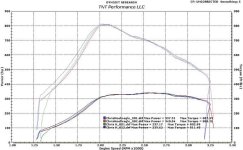c-hawk
Liberals Suck...
- Joined
- Jun 26, 2006
- Messages
- 670
Both charts show the same 4 pulls, all made on the exact same dyno, with the exact same truck with the exact same setup. The runs labeled Chris Hoofnagle 001 and Chris Hoofnagle 002 were done in NC (approx 650' elevation, 79*, 75% humidity), and the runs labeled Chris H 001 and Chris H 002 were done in MD (approx 50' elevation, 60*, 35% humidity). Both graphs show the same exact four pulls, the two from NC and the two from MD.
The first graph shows the runs corrected.

The second graph shows the same runs uncorrected.

The corrected runs show a spread of 21+hp and 50+ ft lbs tq difference from the two locations. The uncorrected runs were all within 3hp and 9 ft lbs tq, regardless of location.
I still believe hot, muggy air takes away power and makes it harder to light the charger, etc., but the correction factors are way off on our trucks... more wrong then right i think.
Chris
The first graph shows the runs corrected.

The second graph shows the same runs uncorrected.

The corrected runs show a spread of 21+hp and 50+ ft lbs tq difference from the two locations. The uncorrected runs were all within 3hp and 9 ft lbs tq, regardless of location.
I still believe hot, muggy air takes away power and makes it harder to light the charger, etc., but the correction factors are way off on our trucks... more wrong then right i think.
Chris



